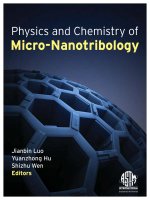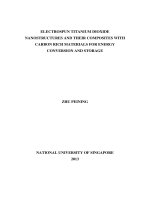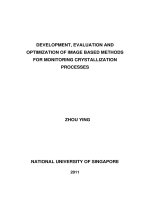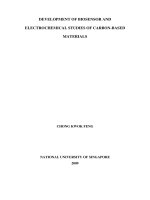Nato science series ii mathematics physics and chemistry new carbon based materials for electrochemical energ
Bạn đang xem bản rút gọn của tài liệu. Xem và tải ngay bản đầy đủ của tài liệu tại đây (42.44 MB, 527 trang )
New Carbon Based Materials for Electrochemical
Energy Storage Systems: Batteries, Supercapacitors
and Fuel Cells
NATO Science Series
ASeries presenting the results of scientific meetings supported under the NATO Science
Programme.
The Series is published by IOS Press, Amsterdam, and Springer in conjunction with the NATO
Public Diplomacy Division
Sub-Series
I. Life and Behavioural Sciences
II. Mathematics, Physics and Chemistry
III. Computer and Systems Science
IV. Earth and Environmental Sciences
IOS Press
Springer
IOS Press
Springer
The NATO Science Series continues the series of books published formerly as the NATO ASI Series.
The NATO Science Programme offers support for collaboration in civil science between scientists of
countries of the Euro-Atlantic Partnership Council. The types of scientific meeting generally supported
are “Advanced Study Institutes” and “Advanced Research Workshops”, and the NATO Science Series
collects together the results of these meetings. The meetings are co-organized bij scientists from
NATO countries and scientists from NATO’s Partner countries – countries of the CIS and Central and
Eastern Europe.
Advanced Study Institutes are high-level tutorial courses offering in-depth study of latest advances
in a field.
Advanced Research Workshops are expert meetings aimed at critical assessment of a field, and
identification of directions for future action.
As a consequence of the restructuring of the NATO Science Programme in 1999, the NATO Science
Series was re-organised to the four sub-series noted above. Please consult the following web sites for
information on previous volumes published in the Series.
/>
Series II: Mathematics, Physics and Chemistry – Vol. 229
New Carbon Based Materials
for Electrochemical Energy
Storage Systems: Batteries,
Supercapacitors and Fuel Cells
edited by
Igor V. Barsukov
Superior Graphite Co., Chicago, IL, U.S.A.
Christopher S. Johnson
Argonne National Laboratory, Argonne, IL, U.S.A.
Joseph E. Doninger
Dontech Global, Inc., Lake Forest, IL, U.S.A.
and
Vyacheslav Z. Barsukov
Kiev National University of Technologies and Design,
Kiev, Ukraine
Published in cooperation with NATO Public Diplomacy Division
NATO - Carbon Advanced Research Workshop and Conference
New Carbon Based Materials for Electrochemical Energy Storage Systems
Argonne, Illinois, U.S.A.
19-24 October 2003
A C.I.P. Catalogue record for this book is available from the Library of Congress.
ISBN-10
ISBN-13
ISBN-10
ISBN-13
ISBN-10
ISBN-13
1-4020-4811-4 (PB)
978-1-4020-4811-1 (PB)
1-4020-4810-6 (HB)
978-1-4020-4810-4 (HB)
1-4020-4812-2 (e-book)
978-1-4020-4812-8 (e-book)
Published by Springer,
P.O. Box 17, 3300 AA Dordrecht, The Netherlands.
www.springer.com
Printed on acid-free paper
All Rights Reserved
© 2006 Springer
No part of this work may be reproduced, stored in a retrieval system, or transmitted in
any form or by any means, electronic, mechanical, photocopying, microfilming,
recording or otherwise, without written permission from the Publisher, with the exception
of any material supplied specifically for the purpose of being entered and executed on a
computer system, for exclusive use by the purchaser of the work.
Printed in the Netherlands.
TABLE OF CONTENTS
Preface ......................................................................................................... xi
Letter from Dr. Hermann Grunder – ANL.................................................. xiii
Photographs & Comments .......................................................................... xiv
Organization............................................................................................... xvii
List of Participants .................................................................................... xviii
Chapter 1
New Carbon Materials for Supercapacitors ............................................. 1
Subject Overview............................................................................... 3
Novel Carbonaceous Materials for Application in the
Electrochemical Supercapacitors ................................................ 5
E. Frackowiak, J. Machnikowski and F. Béguin
Effect of Carbonaceous Materials on Performance of
Carbon-Carbon and Carbon-Ni Oxide Types of
Electrochemical Capacitors with Alkaline
Electrolyte ................................................................................. 21
A. I. Belyakov
Hybrid Supercapacitors Based on a-MnO2/Carbon
Nanotubes Composites.............................................................. 33
V. Khomenko, E. Raymundo-Piñero and F. Béguin
Development of Supercapacitors Based on
Conducting Polymers ................................................................ 41
V. Khomenko, E. Frackowiak, V. Barsukov, and F. Béguin
Supercapacitors: Old Problems and New Trends...................... 51
Y. Malein, N. Strizhakova, V. Izotov, A. Mironova,
S. Kozachkov, V. Danilin and S. Podmogilny
Modeling Porosity Development During KOH
Activation of Coal and Pitch-Derived Carbons for
Electrochemical Capacitors....................................................... 63
K. Kierzek, G. Gryglewicz and J. Machnikowski
v
vi
General Properties of Ionic Liquids as Electrolytes
for Carbon-Based Double Layer Capacitors.................................... 73
A. Lewandowski and M. Galinski
Chapter 2:
Carbon Materials for Gas Diffusion Electrodes, Metal Air
Cells and Batteries.................................................................................. 85
Subject Overview............................................................................. 87
New Concept for the Metal-Air Batteries Using Composites:
Conducting Polymers/Expanded Graphite as Catalysts................... 89
V. Z. Barsukov, V. G. Khomenko, A. S. Katashinskii
and T. I. Motronyuk
Mechanically Rechargeable Magnesium-Air Cells with
NaCl-Electrolyte ............................................................................ 105
A. Kaisheva and I. Iliev
Application of Carbon-Based Materials in Metal-Air
Batteries: Research, Development, Commercialization ................ 117
A. Kaisheva and I. Iliev
Metal – Air Batteries with Carbonaceous Air Electrodes and
Nonmetallic Catalysts .................................................................... 137
N. Korovin
Chapter 3:
Carbon Anodes for Lithium-Ion Batteries............................................ 151
Subject Overview........................................................................... 153
Carbonaceous Materials for Batteries............................................ 157
T. Takamura and R. J. Brodd
Anode-Electrolyte Reactions in Li Batteries:
The Differences Between Graphitic and Metallic Anodes ............ 171
H. J. Santner, K. C. Möller, W. Kohs, C. Veit, E. Lanzer,
A. Trifonova, M. R. Wagner, P. Raimann, C. Korepp, J. O.
Besenhard and M. Winter
vii
Performance of Novel Types of Carbonaceous Materials in
the Anodes of CLAiO’s Lithium-Ion Battery Systems.................. 189
M. Walkowiak, K. Knofczynski, D. Waszak, M. Kopczyk,
M. Rusinek and J. Machnikowski
Why Graphite Electrodes Fail in PC Solutions: An
Insight from Morphological Studies .............................................. 197
D. Aurbach, M. Koltypin, H. Teller and Y. S. Cohen
New Developments in the Advanced Graphite for
Lithium-Ion Batteries..................................................................... 213
F.-X. Henry, I. V. Barsukov, J. E. Doninger, S. Anderson,
P. R. Booth, P. L. Zaleski, R. J. Girkant, D. J. Derwin,
M. A. Gallego, T. Huerta and G. Uribe
Mechanisms of Reversible and Irreversible Insertion in
Nanostructured Carbons Used for Li-Ion Batteries ....................... 231
F. Béguin, F. Chevallier, M. Letellier, C. Vix, C. Clinard,
J. N. Rouzaud and E. Frackowiak
Some Thermodynamics and Kinetics Aspects of the GraphiteLithium Negative Electrode for Lithium-Ion Batteries.................. 245
R. Yazami, A. Martinent and Y. Reynier
Characterization of Anodes Based on Various Carbonaceous
Materials for Application in Lithium-Ion Cells ............................. 259
A. N. Kozhevnikov, Y. A. Podalinski, O. R. Yakovleva,
V. S. Kotlyar, M. E. Petropavlovski, V. G. Smirnov and
V. V. Dzhurzha
A Carbon Composite for the Negative Electrode of Li-Ion
Batteries ......................................................................................... 269
A. V. Churikov, N. A. Gridina and N. V. Churikova
Electrochemical Intercalation of PF 6 and BF 4
into Single-Walled Carbon Nanotubes .......................................... 277
R. Yazami, I. V. Goncharova and V. N. Plakhotnik
viii
Surface Treated Natural Graphite as Anode Material
for High-Power Li-Ion Battery Applications................................. 283
J. Liu, D. Vissers, K. Amine, I. B. Barsukov and J. E. Doninger
Chapter 4 :
Emerging Metal/Carbon Composite Anodes for Next
Generation Lithium-Ion Batteries ........................................................ 293
Subject Overview........................................................................... 295
On The Theoretical Prerequisites for Application of Novel
Materials in Promising Energy Systems ........................................ 297
V. Z. Barsukov and J. E. Doninger
Capabilities of Thin Tin Films as Negative Electrode Active
Materials for Lithium-Ion Batteries ............................................... 309
Y. O. Illin, V. Z. Barsukov and V. S. Tverdokhleb
Composite Anode Materials for High Energy Density
Lithium-Ion Batteries..................................................................... 317
J. S. Gnanaraj, M. K. Gulbinska, J. F. DiCarlo, I. V. Barsukov,
N. Holt, V. Z. Barsukov and J. E. Doninger
Electrochemical Activity of Carbons Modified by d-Metal
Complexes with Ethanolamines..................................................... 333
L. G. Reiter, V. A. Potaskalov, A. A. Andriiko,
V. S. Kublanovsky, M. A. Chmilenko, Y. K. Pirskiy,
V. I. Lisin and S. M. Chmilenko
Metal-Graphite Composites as Materials for Electrodes of
Lithium-Ion Batteries..................................................................... 345
L. Matzui, M. Semen’ko, M. Babich and L. Kapitanchuk
Electrochemical Performance of Ni/Cu-Metallized & CarbonCoated Graphites for Lithium Batteries......................................... 357
C. S. Johnson, K. Lauzze, N. Kanakaris, A. Kahaian,
M. M. Thackeray, K. Amine, G. Sandí-Tapia, S. A. Hackney
and R. O. Rigney
ix
Chapter 5:
New Nano- Through Macro-Carbons for Energy Systems:
Synthesis, Modeling, Characterization................................................. 377
Subject Overview........................................................................... 379
Stabilization of Graphite Nitrate via Co-intercalation of Organic
Compounds .................................................................................... 381
M. V. Savoskin, A. P. Yaroshenko, R. D. Mysyk
and G. E. Whyman
Electrochemical Stability of Natural, Thermally Exfoliated and
Modified Forms of Graphite towards Electrochemical
Oxidation ....................................................................................... 389
I. O. Kovalenko, M. L. Barsukov, V. Z. Barsukov
and Y. V. Myshko
Low Temperature Synthesis of Graphite from Iron
Carbide .......................................................................................... 399
S. Dimovski, A. Nikitin, H. Ye and Y. Gogotsi
High Resolution Transmission Electron Microscopy Image
Analysis of Disordered Carbons Used for Electrochemical
Storage of Energy .......................................................................... 411
J.-N. Rouzaud, C. Clinard, F. Chevallier, A. Thery and F. Béguin
Electrolytes of Carbamide-Chloride Melts at Inert
Electrodes ...................................................................................... 425
S. A. Kochetova and N. Kh. Tumanova
Graphite Intercalation as a Way to Carbon-Carbon
Composites and Carbon Nanoscrolls ............................................. 433
M. V. Savoskin, A. P. Yaroshenko, V. N. Mochalin,
N. I. Lazareva and T. E. Konstantinova
Chapter 6:
Carbons in the Cathodes of Lithium-Ion Batteries; Alternative
Forms of MnO2, Cathode/Carbon Modeling ........................................ 441
Subject Overview........................................................................... 443
x
Diagnostic Evaluation of Power Fade Phenomena and
Calendar Life Reduction in High-Power Lithium-Ion
Batteries ......................................................................................... 445
R. Kostecki and F. McLarnon
Modeling of Electrochemical Processes in the Electrodes
Based on Solid Active Reagents and Conductive Carbon
Additives........................................................................................ 453
V. V. Matveyev
On the Optimal Design of Amorphous Mangaense Oxide
For Applications in Power Sources................................................ 473
S. A. Kirillov, T. V. Lesnichaya, N. M. Visloguzova,
S. A. Khainakov, O. I. Pendelyuk, D. I. Dzanashvili,
T. A. Marsagishvili, V. Z. Barsukov, V. G. Khomenko,
A. V. Tkachenko, and S. I. Chernukhin
Investigation of Cathodic Materials Based on Different
Types of MnO2/Carbon.................................................................. 481
I. S. Makyeyeva, N. D. Ivanova, and G. V. Sokolsky
Investigation of Thin-Film Electrode Materials as
Cathodic Actives for Power Sources ............................................. 487
N. E. Vlasenko, N. D. Ivanova, E. I. Boldyrev, and
O. A. Stadnik
Synthesis of Mixed Oxides using Polybasic Carboxylic
Hydroxy-and Amino-Acid Routes: Problems and
Prospects ........................................................................................ 495
S. A. Kirillov, I. V. Romanova, and I. A. Farbun
Improved Electrochemical Properties of Surface-Coated
Li(Ni,Co,Mn)O2 Cathode Material for Li Secondary
Batteries ......................................................................................... 505
S. H. Kang and K. Amine
Index
....................................................................................................... 513
PREFACE
Carbonaceous materials play a fundamental role in electrochemical
energy storage systems. Carbon in the structural form of graphite is widely
used as the active material in lithium-ion batteries; it is abundant, and
environmentally friendly. Carbon is also used to conduct and distribute
charge effectively throughout composite electrodes of supercapacitors,
batteries and fuel cells. The electronic conductive pathways are critical to
delivering and extracting current out of the device. However, many
challenges and the understanding of the role of carbon and its stability and
efficiency in charge storage applications still exists. This NATO-ARW
volume contains a diverse collection of papers addressing the role of carbon
in some key electrochemical systems, both conventional and emerging.
These papers discuss the latest issues associated with development,
synthesis, characterization and use of new advanced carbonaceous materials
for electrochemical energy storage. Such systems include: metal-air primary
and rechargeable batteries, fuel cells, supercapacitors, cathodes and anodes
of lithium-ion and lithium polymer rechargeable batteries, as well as
nanocarbon materials of the future.
In the present volume, these papers originate from most of the
lectures given at the NATO-Carbon Advanced Research Workshop and
Conference (NATO-CARWC). Forty-one papers and six chapters are
presented in this book. The order of papers in each chapter in this volume
followed the order of lectures during the conference. This workshop and
conference featured papers from leading researchers in the field of
supercapacitors and batteries as well as papers from scientists and engineers
from the former Soviet Union (Russia and Ukraine) and other Eastern
European countries, such as Bulgaria and Poland. The workshop and
conference was held at Argonne National Laboratory in Argonne, Illinois
from October 20 to 23, 2003. A total number of registrants of approximately
90 were in attendance. Of these, approximately 21 Ukrainian and Russian
delegates were present. Roughly 16 other presenters were from NATO and
Mediterranean countries, and an additional 10 from the United States of
America. The remainder participants came from national laboratories,
government agencies, academia, and industry around the United States
whom are interested in energy storage research and technologies.
We thank all the presenters who contributed to this book and
appreciate their time spent in preparing their presentations for the conference
and manuscripts for this volume. We acknowledge the National University
of Technologies and Design (Kiev, Ukraine), Center for Research on
Divided Materials (CRDM-Orleans, France), and Poznan University of
xi
xii
Technology (Poland) for their participation and assistance in identifying
speakers from the Ukraine and Russia. We also thank all other registrants for
coming and making the workshop and conference a success.
Finally we acknowledge the NATO Science Committee, and are
grateful to the Civilian Research and Development Foundation (CRDF),
which provided funding in the form of individual travel grants for the invited
scientists and engineers from the Ukraine and Russia. In addition we would
like to thank the NATO-Science for Peace Program, Superior Graphite Co.,
Argonne National Laboratory, the National Renewable Energy Laboratory,
Lawrence Berkeley National Laboratory, Illinois Institute of Technology,
Gas Technology Institute and Broddarp of Nevada, Inc. for financial
sponsorship assistance.
We would like to specifically acknowledge logistical support from
the following individuals: Laurie Carbaugh and Joan Brunsvold (Argonne
National Laboratory), Maritza Gallego, Gabriela Uribe and Peter R. Carney
(Superior Graphite Co.), Dr. Chris De Wispelaere (Science for Peace
program, NATO), Dr. Fausto Pedrazzini (ARW Program, NATO), Dr.
Michael Onischak and Michael Romanco (Gas Technology Institute),
Professor Jai Prakash and Dr. Said Al-Hallaj (Illinois Institute of
Technology), Ross Campbell (Next Steps to Market Program, U.S. Civilian
Research and Development Foundation), Chris Hilton (Travel Grants
Program, U.S. Civilian Research and Development Foundation).
Last but not least, the editors wish to express gratitude to those loved
members of our families and friends, who inspired and supported us during
preparation of this volume for press.
Igor V. Barsukov
Christopher S. Johnson
Joseph E. Doninger
Vyacheslav Z. Barsukov
ARGONNE NATIONAL LABORATORY
9700 SOUTH CASS AVENUE, ARGONNE, ILLINOIS 60439-4832
OFFICE OF THE DIRECTOR
(630) 252-2481 / FAX (630) 252-7923
October 20, 2003
Dear Participants,
On behalf of Argonne National Laboratory, I would like to welcome you to Argonne
National Laboratory and the NATO Carbon Advanced Research Workshop and
Conference. This event, which brings together innovative scientists and engineers
from many organizations and nations, is part of the NATO Science for Peace
program initiative to encourage fruitful collaborations between former Warsaw pact
countries and the United States and other Western nations. International
collaborations like these have become especially important in today’s climate, and I
am pleased that so many leading experts from government, industry, and academia
are in attendance.
I invite you to take advantage of the tours of the laboratory. As the nation’s first
national laboratory, Argonne has a unique mix of history and leading-edge
technology throughout its 1,500-acre site. Events will come to a close with a private
tour and dinner at the Museum of Science and Industry, one of Chicago’s great
treasures.
I am confident that this meeting will be a stimulating and productive one. As
scientists and engineers dedicated to peaceful collaboration, I trust your vision and
efforts will carry electrochemical technology to new heights.
Sincerely,
Hermann A. Grunder
Director of Argonne National Laboratory
OPERATED by THE UNIVERSITY of CHICAGO for THE UNITED
STATES DEPARTMENT of ENERGY
xiii
PHOTOGRAPHS AND COMMENTS
Group Photograph, Argonne National Laboratory, Argonne, IL USA (Courtesy C. Johnson)
Technical discussions during the poster session. Left to right: Professor R. Yazami
(CALTEC / CNRS, USA-France), Dr. I.
Goncharova (Dniepropetrovsk National
Univ. of Railway Transport, Ukraine) and
Professor M. Winter (Graz Technical Univ.,
Austria). Courtesy M. Gallego. o
Eastern European participants of the NATOARW during the downtown Chicago city
tour. Courtesy Dr. V. Matveev. p
A satellite meeting during the NATO-ARW. nPlanning of what later resulted in a start of a
high profile U.S. Department of Energy Initiative for Proliferation Prevention project
between the Argonne National Laboratory, Superior Graphite Co. (Chicago, IL, USA) and
three ex-weapons institutes, and other organizations in Ukraine (Headquarters SGC,
downtown Chicago).
xiv
xv
PHOTOGRAPHS AND COMMENTS
Courtesy Prof. Doninger.
A honorary NATO-CARWC award for
significant contribution to the science of
carbon for power sources is being given by
Dr. I. Barsukov (workshop co-organizer) to
Prof. D. Aurbach (Bar-Ilan Univ., Israel).
Sitting are other awardees: S. Dimovski
(Drexel Univ., USA (left), and Prof. R.
Yazami (Caltech/CNRS – USA/France).
m At the renowned Chicago’s
Museum of Science and Industry,
posing in the Space Exhibit are
from left: Prof. J. Machnikowski
(Wroclaw Univ. of Technology,
Poland), M. Gallego and J. Chavez
(Superior Graphite, USA), Y. Il’in
(Kiev National University of
Technology & Design, Ukraine),
Prof. F. Beguin (CNRS, France),
Dr. E. Frackowiak (Inst. of
Chemistry & Technical Electrochemistry, Poland) and Dr. Neal
White (Sion Power Research, Great
Britain).
m Conducting a technical tour of
Superior Graphite’s Peter R.
Carney Technology Center is one
of the inventors of expanded
graphite for batteries, Peter Zaleski,
Lab Director (center); Listening
left to right are: Prof. Y. Maletin
(National Technical Univ. of
Ukraine “KPI”), Dr. N. White
(Sion Power Research, Great
Britain), Dr. A. Hull (Argonne
National Lab, USA), Mr. M.
Walkowiak (CLAiO, Poland), and
Mr. V. Khomenko (Kiev National
University of Technology &
Design, Ukraine).
Dr. N. Vlasenko (left) of the Institute of
General & Inorganic Chemistry, Ukraine and
Dr. V. Kotlyar of Research Institute
“Istochnik”, Russia observe a high temperature fuel cell, as shown by Dr. R. Remick
during a tour to Gas Technology Institute (a
leading fuel cell technology organization in
greater Chicago area). Courtesy V. Matveev.
ORGANIZATION
(i)
USA Director:
Dr. Joseph E. Doninger– President, Dontech Global, Inc.
Dontech Global, Inc.
427 East Deerpath Rd., Lake Forest, IL 60045, USA
(224) 436-4835 (phone); +1 (847) 234-4835 (fax);
(ii) USA Co-director:
Dr. Christopher S. Johnson – Staff Chemist
Electrochemical Technology Program
Chemical Engineering Division
Argonne National Laboratory
9700 S. Cass Ave., Argonne, IL 60565, USA
(630)-252 4787 (phone); (630)-252 4176 (fax);
(iii) Ukraine Co-director:
Prof. Dr. Vyacheslav Z. Barsukov – Head of Chemistry Department
National University of Technologies and Design, Department of
Chemistry, 2, Nemirovich-Danchenko street, Kiev, 252011, Ukraine
+ 38 (044) 291-2102 (phone); + 38 (044) 290-1603 (fax);
Local Organizing Committee
(i)
(ii)
(iii)
(iv)
(v)
Dr. Igor Barsukov Superior Graphite Co., Peter R. Carney
Technology Center, 201 West 36th Street, Chicago, IL,
60632, USA, Phone: (773) 890-4117, Fax: (773) 890-4121,
E-mail:
Dr. Christopher S. Johnson, Chair (Argonne National
Laboratory, ANL)
Dr. Joe Doninger (Superior Graphite Co.)
Mr. Gary Henriksen (ANL), phone (630) 252-4591
Dr. James Miller (ANL), phone (630) 252-4537
xvii
LIST OF PARTICIPANTS
Oleksandr Andriiko
Terrill Atwater
Doron Aurbach
James Barnes
Igor Barsukov
Vyacheslav Barsukov
James Beckwith
Francois Béguin
Alexey Belyakov
Ira Bloom
Peter Booth
Ralph Brodd
Ross Campbell
Chemical Engineering Faculty, Kiev National
Technical University, Polytechnik Institute (NTUU
KPI), 7 Peremogy Prospekt, 03056 Kiev, Ukraine,
Army Power, U.S. Army CECOM, AMSEL-RD-C2AP-B, Fort Monmouth, NJ 07703, USA,
Department of Chemistry, Bar-Ilan University
Remat ban 53900, Israel,
U.S. Department of Energy, EE-2G, 1000
Independence Avenue, SW, Washington, DC 20585,
USA,
Department of Research & Development, Superior
Graphite Company, 4201 West 36th Street, Chicago,
IL 60629, USA,
Electrochemical Power Engineering & Chemistry
Kiev National University of Technologies an Design
Nemirovich-Danchenko str. 2 02011 Kiev, Ukraine
Power Sources Center, 3206 Kinross Circle, Herndon,
VA 20171, USA,
CRMD, CNRS – University of Orléans
1b, rue de la Férollerie, 45071 Orléans, France
Management Department, ELIT Electrochemical
Power Sources Co., 40, Rpospect Leninscogo
Komsomola, 305026 Kursk, Russia
Chemical Engineering Division, Argonne National
Laboratory, Bldg. 205, 9700 South Cass Avenue,
Argonne, IL 60439, USA
Technology Department, Superior Graphite Company
10 South Riverside Plaza, Chicago. IL 60606 USA
Broddarp of Nevada, Inc., 2161 Fountain Springs
Drive, Henderson, NV 89074
Next Steps to Market, U.S. Civilian Research &
Development Foundation (CRDF), 1530 Wilson
Boulevard, Arlington, VA 22209, USA
xviii
xix
Peter Carney
Alexi Churikov
Svetlana Dimovski
Joseph Doninger
Charles Drews
Harvey Drucker
Elzbieta Frackowiak
Arkadiy Furman
Maritza Gallego
Rex Gerald
Steve Gerts
Yury Gogotsi
Irina Goncharova
Diane Graziano
Gary Henriksen
Executive Department, Superior Graphite Company
10 South Riverside Plaza, Chicago, IL 60606, USA
Chemistry Department, Saratov State University
83, Astrakhanskaya, 410012 Saratov, Russia
Department of Materials Science and Engineering
Drexel University, Lewbow 344, 3141 Chestnut
Street, Philadelphia, PA 19104, USA
Dontech Global, Inc., 427 East Deerpath Rd., Lake
Forest, IL 60045, USA
EMS, Inc., 165 King Street, Elk Grove Village, IL
60007, USA,
Energy & Environmental Science & Technology
Argonne National Laboratory, Bldg. 202
9700 South Cass Avenue, Argonne, IL 60439, USA
Institute of Chemistry & Technical Electrochemistry
Poznan University of Technology, Piotrowo 3, 60-965
Poznan, Poland,
EMS, Inc., 165 King Street, Elk Grove Village, IL
60007, USA,
Department of Research & Development, Superior
Graphite Company, 4201 West 36th Street, Chicago,
IL 60632, USA,
Chemical Engineering Division, Argonne National
Laboratory, Bldg. 205, 9700 South Cass Avenue,
Argonne, IL 60439, USA,
R&D Department, Amtek Research International
250 North Hansard Ave., Lebanon, OR 97355, USA
Department of Materials Science & Engineering
Drexel University, Lebow 344, 3141 Chestnut Street
Philadelphia, PA 19104, USA,
Department of Chemistry & Engineering Ecology
Dnieproppetrovsk National University of Railway
Transport, 2 Academika Lazaryana St., 49010
Dniepropetrovsk, Ukraine
Chemical Engineering Division, Argonne National
Laboratory, Bldg. 205, 9700 South Cass Avenue,
Argonne, IL 60439, USA,
Chemical Engineering Division, Argonne National
Laboratory, Bldg. 205, 9700 South Cass Avenue,
Argonne, IL 60439, USA,
xx
Superior
Francois-Xavier Henry Department of Research & Development,
th
Amy Hull
Ilia Illiev
Yevgen Ilyin
Andrew Jansen
Christopher Johnson
Donald Joyce
Arthur Kahaian
Anastassia Kaisheva
Sun-Ho Kang
Volodimir Khomenko
Jeom-Soo Kim
Sviatoslav Kirillov
Arkadiy Klementov
Graphite Company, 4201 West 36 Street, Chicago,
IL 60632, USA,
Energy Technology Division, Argonne National
Laboratory, Bldg. 212, 9700 South Cass Avenue,
Argonne, IL 60439, USA,
Electrochemistry of Biocatalytic & Metal-Air
Systems, Central Laboratory of Electrochemical
Power Sources, Acad. G. Bonchev Str., bl. 10, 1113
Sofia, Bulgaria,
Electrochemical Energetics & Chemistry, Kiev
National University of Technologies & Design
Nemirovich-Danchenko str., 2, 02001 Kiev, Ukraine
Chemical Engineering Division, Argonne National
Laboratory, Bldg. 205, 9700 South Cass Avenue,
Argonne, IL 60439, USA,
Chemical Engineering Division, Argonne National
Laboratory, Bldg. 205, 9700 South Cass Avenue,
Argonne, IL 60439, USA,
Office of the Laboratory Director, Argonne National
Laboratory, Bldg. 201, 9700 South Cass Avenue,
Argonne, IL 60439, USA,
Chemical Engineering Division, Argonne National
Laboratory, Bldg. 205, 9700 South Cass Avenue,
Argonne, IL 60439, USA,
Electrochemistry of Biocatalytic & Metal-Air
Systems, Central Laboratory of Electrochemical
Power Sources, Acad. G. Bonchev str., bl. 170, 1113
Sofia, Bulgaria,
Chemical Engineering Division, Argonne National
Laboratory, Bldg. 205, 9700 South Cass Avenue,
Argonne, IL 60439, USA,
Electrochemical Power Engineering & Chemistry
Kiev national University of Technologies & Design,
Nemirovich-Danchenko Str., 2, 02011 Kiev, Ukraine
Chemical Engineering Division, Argonne National
Laboratory, Bldg. 205, 9700 South Cass Avenue,
Argonne, IL 60439, USA,
Institute for Sorption & Problems of Endoecology,
National Academy of Scienes, 13, Naumov St., 03164
Kiev, Ukraine,
JME, Inc., 17210 Parkland Drive, Shaker Heights,
OH 44120, USA,
xxi
Svitlana Kochetova
Robert Kostecki
Vladimir Kotlyar
Igor Kovalenko
Alexander
Kozhevniko
David Laughton
Andrzej Lewandowski
David Lewis
Jun Liu
Jacek Machnikowski
Irina Najteteva
Yurii Maletin
Vadym Matveyev
N11-High Temperature Electrochemical Synthesis,
National Academy of Sciences, Institute of General &
Inorganic Chemistry, 32/34 Palladin Avenue, 03680
Kiev, Ukraine,
Environmental Energy Technologies, Lawrence
Berkeley National Laboratory, 1 Cyclotron Road,
Berkeley, CA 94720, USA,
Reliability Department, Accumulator Research &
Design Institute “Istochnik”, 10, Dahl Street, 197376
Saint-Petersburg, Russia,
Ministry for Emergency Management of Chemistry,
Ukrainian Fire Safety Research Institute, 18,
Rybarskya Street, 01011 Kiev, Ukraine
N20, Acumulator Research & Design Institute
“Istochnik”, 10, Dahl Street, 197376 Saint-Petersburg,
Russia,
Sales Department, Superior Graphite Company
10 South Riverside Plaza, Chicago, IL 60606, USA
Faculty of Chemical Technology, Poznan University
of Technology, ul. Piotrowo 3, 60-965 Poznan,
Poland,
Chemical Engineering Division, Argonne National
Laboratory, Bldg. 205, 9700 South Cass Avenue,
Argonne, IL 60439, USA,
Chemical Engineering Division, Argonne National
Laboratory, Bldg.205, 9700 South Cass Avenue,
Argonne, IL 60439, USA,
Institute of Chemical & Technology of Petroleum and
Coal, Wroclaw University of Technology, Gdanska
7/9, 50 344 Wroclaw, Poland,
Electrochemical Power Engineering & Chemistry,
Kiev National University of Technologies & Design,
Nemirovich-Danchenco str., 2, 02011 Kiev, Ukraine,
Department of Physical Chemistry, National
Technical University of Ukraine “KPI”, 37 Prospect
Peremohy, 03056 Kiev, Ukraine,
Scientific Research Laboratory of Storage-Battery
System, Ukrainian State University of Chemical
Engineering, 8, Gagarin Avenue, 49005
Dniepropetrovsk, Ukraine,
xxii
Luidmila Matzui
Dayal Meshri
James Miller
Vadim Mochalin
Michael Onischak
Oksana Pendelyuk
Iouri Prokofiev
Encarnacion
Raymundo-Pinero
Michael Romanco
Jean-Noel Rouzaud
Giselle Sandi-Tapia
Michael Savoskin
Sergiy Yu Sayenko
Department of Biophysics, Kyiv National
Shevchenko University Volodymyrska Str., 64, Kyiv,
Ukraine, matzui@mail/univ/kiev/ua
Advance Research Chemicals, Inc., 1110 West
Keystone Avenue, Catoosa, OK 74015, USA,
Chemical Engineering Division, Argonne National
Laboratory, Bldg. 205, 9700 South Cass Avenue,
Argonne, IL 60439, USA,
Chemistry of Molecular Complexes, National
Academy of Sciences, L.M. Litvinenko Institute of
Physical Organic & Coal Chemistry, R. Luxemburg
Str., 70, 83114 Donetsk, Ukraine,
Department of Hydrogen & Distributed Energy, Gas
Technology Institute, 1700 South Mount Prospect
Road, Des Plaines, IL 60018, USA,
National Academy of Sciences, Institute for Sorption
and Problems of Endeocology, 13, Naumov St.,
03164 Kiev, Ukraine, ,ua
Nuclear Engineering Division, Argonne National
Laboratory, Bldg. 206, 9700 South Cass Avenue,
Argonne, IL 60439, USA,
CRMD, CNRS – University of Orléans, 1B rue de la
Férollerie, 45071 Orleans, France,
Department of Hydrogen & Distributed Energy, Gas
Technology Institute, 1700 South Mount Prospect
Road, Des Plaine, IL 60018, USA,
CRMD, CNRS – University of Orléans, 1B rue de la
Férollerie, 45071 Orleans, France,
Chemistry Division, Argonne National Laboratory,
Bldg. 200, 9700 South Cass Avenue, Argonne, IL
60439, USA,
Chemistry of Molecular Complexes, National
Academy of Sciences, L.M. Livinenko Institute of
Physical Organic & Coal Chemistry, R. Luxemburg
Str., 70, 83114 Donetsk, Ukraine,
Institute of Solid State Physics, National Science
Center – KIPT, Materials Science and Technologies,
1, Akadamicheskaya, 61108 Kharkov, Ukraine,
xxiii
Sergiy Sazhin
Kathryn Striebel
Jeffrey Swoyer
Michael Thackeray
Thanh Tran
Gabriela Uribe
Jack Vaughey
Donald Vissers
Natasha Vlasenko
Mariusz Walkowiak
Qingzheng Wang
Robert Waterhouse
Neal White
Martin Winter
Department of Lithium & Rechargeable
Technologies, Rayovac Corporation, 630 Forward
Drive, Madison, WI 53711-2497, USA,
Environmental Energy Technologies Division,
Lawrence Berkeley National Laboratory, MS:
70R0108B, 1 Cyclotron Road, Berkeley, CA 94720,
USA,
Research Department, Valence Technology, Inc., 301
Conestoga Way, Henderson, NV 89015, USA,
Chemical Engineering Division, Argonne National
Laboratory, Bldg. 205, 9700 South Cass Avenue,
Argonne, IL 60439, USA,
Sentech, Inc., 4733 Bethesda Avenue, Bethesda, MD
20814, USA,
Research & Development, Superior Graphite
Company, 4201 West 36th Street, Chicago, IL 60632,
USA,
Chemical Engineering Division, Argonne National
Laboratory, Bldg. 205, 9700 South Cass Avenue,
Argonne, IL 60439, USA,
Chemical Engineering Division, Argonne National
Laboratory, Bldg. 205, 9700 South Cass Avenue,
Argonne, IL 60439, USA,
Photoelectrochemistry & Chemical Power Sources,
National Academy of Sciences, Institute of General &
Inorganic Chemistry, 32/34 Palladin Prospect, 03680
Kiev – 142, Ukraine,
Lithium Batteries Department, Central Laboratory of
Batteries & Cells, Ul. Forteczna 12, 61-362 Poznan,
Poland,
Chemical Engineering Division, Argonne National
Laboratory, Bldg. 205, 9700 South Cass Avenue,
Argonne, IL 60439, USA,
Department of Research & Development, Amtek
Research International, 250 North Hansard Avenue,
Lebanon,OR, 97355, USA,
Sion Power Research, Inc., Sion Power Corporation,
Tanfield Lea Industrial Park, Stanley, Durham DH9
9QF, United Kingdom,
Institute of Chemical Technology of Inorganic
Materials, Graz University of Technology,
Stremayrgasse 16, A-8010 Graz, Austria,
xxiv
Mathis Wissler
Rachid Yazami
Peter Zaleski
Product Management, Superior Graphite Europe,
Kungsmatt 8, Ch 5643 Sins, Switzerland,
Department of Materials Science, CRNS/Caltech,
M/C 183-78, Pasadena, CA 91125, USA,
Laboratory Department, Superior Graphite Company,
4201 West 36th Street, Chicago, IL 60632, USA,
CHAPTER 1:
NEW CARBON MATERIALS FOR
SUPERCAPACITORS
Chapter 1: Subject Overview
A classic definition of electrochemical ultracapacitors or supercapacitors summarizes them as devices, which store electrical energy via
charge in the electrical double layer, mainly by electrostatic forces, without
phase transformation in the electrode materials. Most commercially available
capacitors consist of two high surface area carbon electrodes with graphitic
or soot-like material as electrical conductivity enhancement additives.
Chapter 1 of this volume contains seven papers with overview presentations,
and development reports, as related to new carbon materials for this
emerging segment of the energy market.
In the first paper by E. Frackowiak et al., a French-Polish team of
authors describes properties of new materials produced by KOH activation
of microporous carbon precursors, as well as carbons obtained through the
so-called template synthesis. The authors also devise a carbon-carbon
composite, which has been synthesized via a process of carbonization of
carbon nanotubes with a polyacrylonitrile conducting polymer. It is claimed
that a synergistic effect has been observed with the above composite, while
its individual ingredients show instead negligible capacitance values. An
attempt made by the authors to explain the reported synergistic capacitance
enhancement effect by, exclusively, nitrogen-based surface groups on
carbon, is an interesting, and, perhaps, debatable concept. It may likely
stimulate further discussions and investigative research on the subject.
The second paper, by A. Belyakov, comes from the Russian
supercapacitor industry. This applied work highlights modern industrial
approaches used for boosting the power output characteristics of aqueous
commercial supercapacitors. The author discusses two supercapacitor
chemistries: carbon-carbon and NiOx-carbon. A key emphasis is given to the
role of conductive additives, which constitute up to 40wt% of electrode
composition. Several classes of conductive diluents were investigated, e.g.
Ni powder, colloidal carbon black, expanded and boron-doped flake
graphite. The author concludes that for the carbon-carbon type of
supercapacitors, the most preferable conductive additive should be carbon
material, but the exact type of carbon is of a secondary importance.
However, in the case of asymmetric NiOx-carbon capacitor, boron-doped
graphite showed the biggest promise, due to it being prone to oxidation.
In the third paper by French and Ukrainian scientists (Khomenko et
al.), the authors focus on high performance a-MnO2/carbon nanotube
composites as pseudo-capacitor materials. Somewhat surprisingly, this paper
teaches to use carbon nanotubes for the role of conductive additives, thus
suggesting an alternative to the carbon blacks and graphite materials – low
cost, widely accepted conductive diluents, which are typically used in
todays’ supercapacitors. The electrochemical devices used in the report are
full symmetric and optimized asymmetric systems, and are discussed here
3









